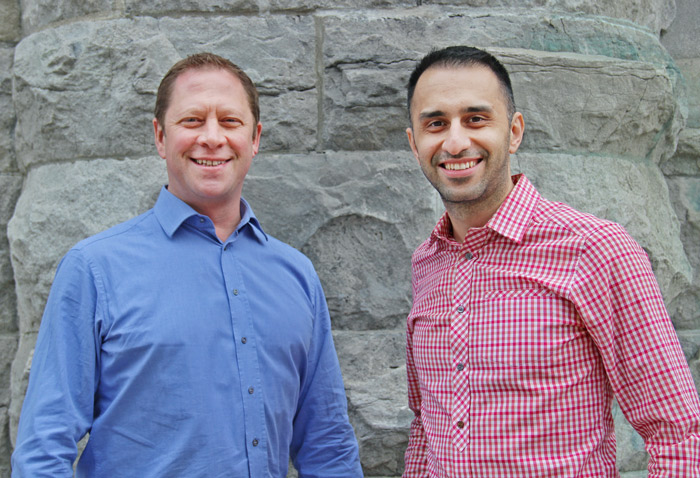The process of manufacturing cement—the primary material used in the production of concrete—accounts for five per cent of the world’s carbon dioxide emissions. The emissions from cement production are unsustainable at the planet’s current rate of development. However, Carbicrete, a McGill-led technology company, has developed patented technology that not only eliminates carbon dioxide emissions from this process, but sequesters carbon as well.
The Carbicrete team is composed of four members: Mehrdad Mahoutian, a research associate in the Department of Civil Engineering and Applied Mechanics at McGill; Chris Stern, a Mechanical Engineering graduate; Yuri Mytko, an MBA-holder who serves as the company’s CMO; and Mario Vendetti, a Mechanical Engineering graduate.
Mahoutian initially developed the idea for Carbicrete while working as a PhD student at McGill.
“We were inspired by the fact that cement production is energy intensive and accelerates global warming,” Mahoutian said. “Our effort was to eliminate this dirty material as one of the raw materials of concrete and at the same time, utilize the waste materials of steel-making factories that mostly end up in landfills, resulting in [further] environmental issues.”
The team formulated a method to produce more durable, sustainable, and cost-effective concrete. While traditional concrete uses Portland cement as the primary binding agent, Carbicrete uses steel slag. Using steel slag is already a significant step towards sustainability, as it reuses a by-product of steel production that would have otherwise been labelled as waste. Additionally, steel slag is beneficial because the team is able to utilize a process called ‘carbonation activation,’ which allows for carbon sequestration. This process occurs after the concrete is first extracted from its mold. Carbon dioxide is then injected into the concrete while it is still fresh and malleable.
The fresh concrete is first placed inside a pressurized chamber, into which carbon dioxide is injected. Over a few hours, a reaction takes place between the slag and the carbon dioxide that develops the strength of the concrete, making it more durable than conventional concrete. The permanent sequestration of carbon dioxide within the material results in carbon-negative concrete.
“Compared to the conventional [concrete] block, Carbicrete is more resistant when subject to freeze and thaw cycles,” Mahoutian explained. “These durability properties may be beneficial for outdoor application, especially in Canada.”
The Carbicrete team has advanced to the semi-finals in the NRG COSIA Carbon XPRIZE competition, thanks to their unique design. Teams from six different countries have developed innovative technologies that aim to convert carbon dioxide into valuable products. For example, another semi-finalist has found a method to form toothpaste from carbon dioxide. The competition began in 2015 and will last four-and-a-half years in total. Semi-finalists will demonstrate their products in a location of their choosing and will be evaluated based on levels of carbon conversion and the net value of their technologies. Teams advancing to the finals must demonstrate the application of their carbon negative products in real coal or natural gas power plants. If Carbicrete wins, they hope to use the $20 million prize to grow the company.
Carbicrete’s current market is limited to Canada, but the company plans to expand to other countries, including the United States and China. Mahoutian does not promise that the expansion will occur overnight, but Carbicrete has already gained traction with local partners and support from the McGill School of Architecture. Within a few years, Carbicrete may be used to pave roads and sidewalks near you.










Kudos to the McGill team that is behind this revolutionary method of producing concrete. I do hope that it ultimately replaces the use of cement throughout the world, but am left wondering how the supply of slag steel compares to the supply of cement. That answer may well influence the long-term viability and success of this venture.
Glad to see the McGill team highlight the fact that cement manufacturing is a significant source of CO2 release. When you think about cement manufacturing it is effectively reversing the natural process of carbon sequestration. In nature, CO2 was used by organisms to create calcium carbonate skeletons that became limestone, which is then heated to release CO2 to form cement. We’ll consider using the Carbicrete in projects where owners want a more sustainable option. Do you know of builders using Carbicrete for LEED or Envision certifications? I am assuming any heavy metals in the slag are effectively sequestered by the infusion of CO2 when making Carbicrete.
The question of slag availability is a good one, but there may be other waste materials (incinerator ash) or natural minerals with the proper composition of calcium, iron, aluminum, silicates, sulfates etc or the basic hydration process once CO2 and water are added.